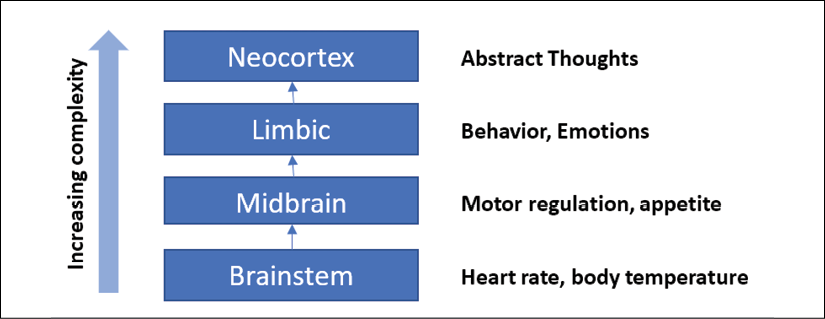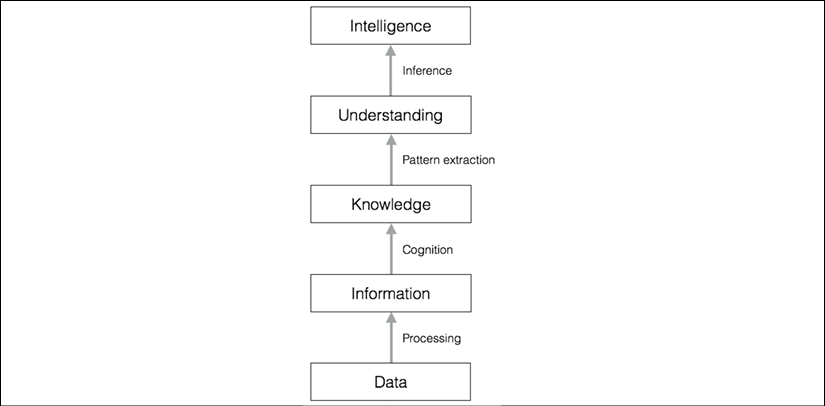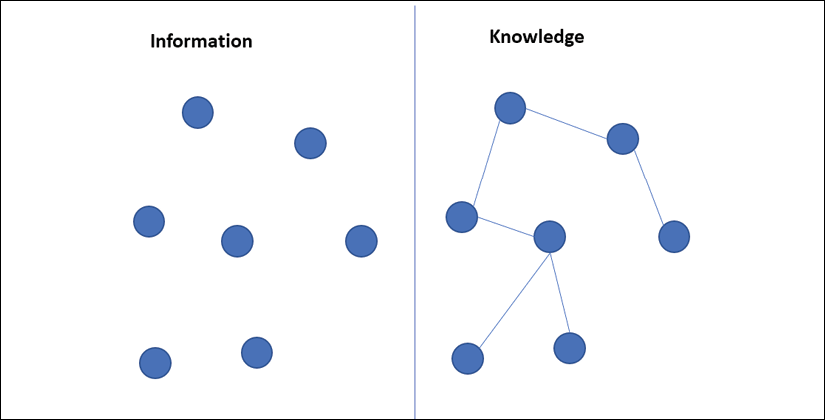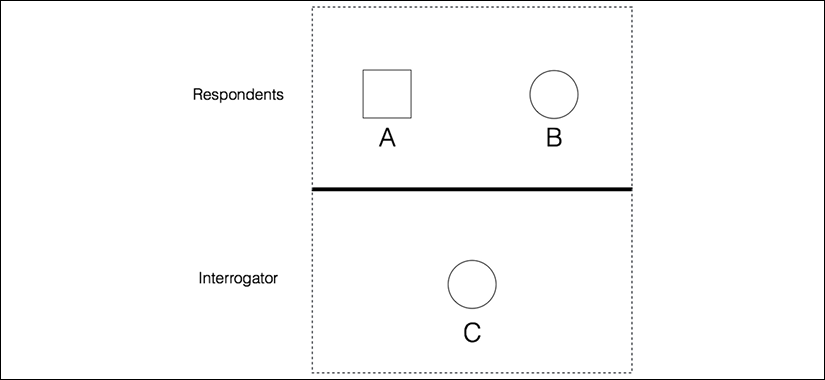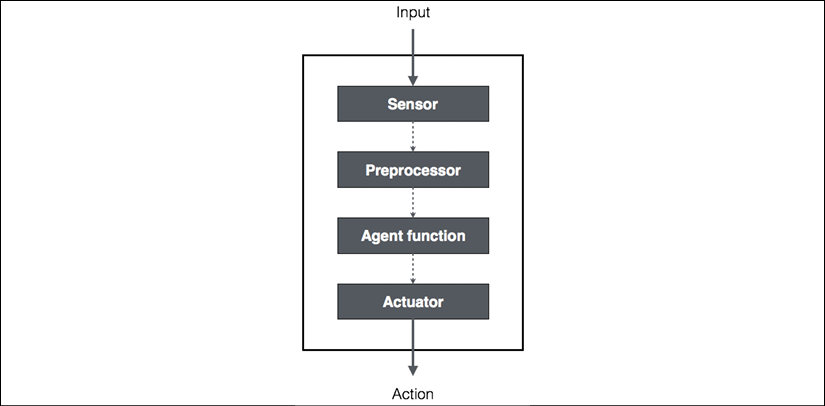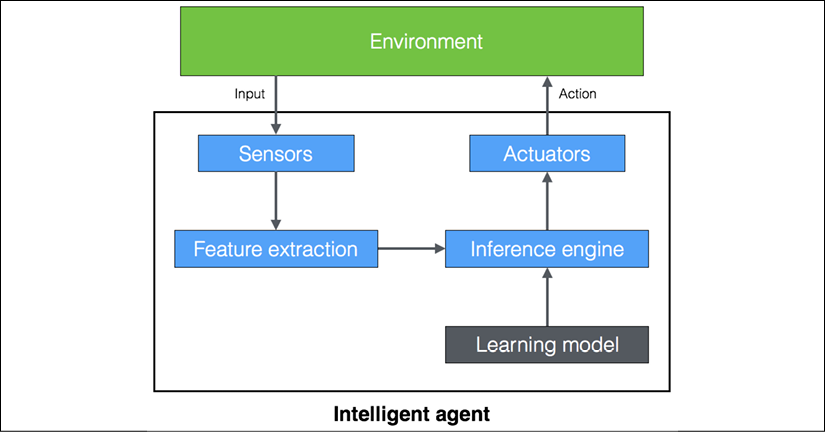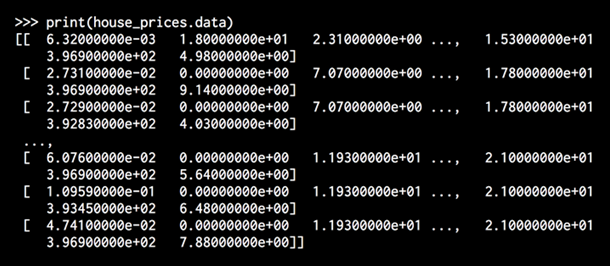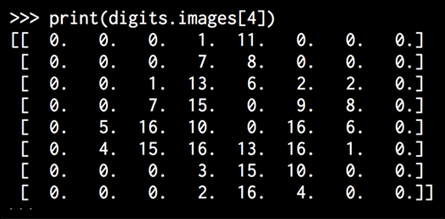Introduction to Artificial Intelligence
In this chapter, we are going to discuss the concept of artificial intelligence (AI) and how it's applied in the real world. We spend a significant portion of our everyday life interacting with smart systems. This can be in the form of searching for something on the internet, biometric facial recognition, or converting spoken words to text. AI is at the heart of all this and it's becoming an important part of our modern lifestyle. All these systems are complex real-world applications and AI solves these problems with mathematics and algorithms. Throughout the book, we will learn the fundamental principles that can be used to build such applications. Our overarching goal is to enable you to take up new and challenging AI problems that you might encounter in your everyday life.
By the end of this chapter, you will know:
- What is AI and why do we need to study it?
- What are some applications of AI?
- A classification of AI branches
- The five tribes of machine learning
- What is the Turing test?
- What are rational agents?
- What are General Problem Solvers?
- How to build an intelligent agent
- How to install Python 3 and related packages
What is AI?
How one defines AI can vary greatly. Philosophically, what is "intelligence?" How one perceives intelligence in turn defines its artificial counterpart. A broad and optimistic definition of the field of AI could be: "the area of computer science that studies how machines can perform tasks that would normally require a sentient agent." It could be argued from such a definition that something as simple as a computer multiplying two numbers is "artificial intelligence." This is because we have designed a machine capable of taking an input and independently producing a logical output that usually would require a living entity to process.
A more skeptical definition might be more narrow, for example: "the area of computer science that studies how machines can closely imitate human intelligence." From such definition skeptics may argue that what we have today is not artificial intelligence. Up until now, they have been able to point to examples of tasks that computers cannot perform, and therefore claim that computers cannot yet "think" or exhibit artificial intelligence if they cannot satisfactorily perform such functions.
This book leans towards the more optimistic view of AI and we prefer to marvel at the number of tasks that a computer can currently perform.
In our aforementioned multiplication task, a computer will certainly be faster and more accurate than a human if the two numbers are large enough. There are other areas where humans can currently perform much better than computers. For example, a human can recognize, label, and classify objects with a few examples, whereas currently a computer might require thousands of examples to perform at the same level of accuracy. Research and improvement continue relentlessly, and we will continue to see computers solving more and more problems that just a few years ago we could only dream of them solving. As we progress in the book, we will explore many of these use cases and provide plenty of examples.
An interesting way to consider the field of AI is that AI is in some ways one more branch of science that is studying the most fascinating computer we know: the brain. With AI, we are attempting to reflect some of the systems and mechanics of the brain within computing, and thus find ourselves borrowing from, and interacting with, fields such as neuroscience.
Why do we need to study AI?
AI can impact every aspect of our lives. The field of AI tries to understand patterns and behaviors of entities. With AI, we want to build smart systems and understand the concept of intelligence as well. The intelligent systems that we construct are very useful in understanding how an intelligent system like our brain goes about constructing another intelligent system.
Let's look at how our brain processes information:
Figure 1: Basic brain components
Compared to some other fields such as mathematics or physics that have been around for centuries, AI is relatively in its infancy. Over the last couple of decades, AI has produced some spectacular products such as self-driving cars and intelligent robots that can walk. Based on the direction in which we are heading, it's obvious that achieving intelligence will have a great impact on our lives in the coming years.
We can't help but wonder how the human brain manages to do so much with such effortless ease. We can recognize objects, understand languages, learn new things, and perform many more sophisticated tasks with our brain. How does the human brain do this? We don't yet have many answers to that question. When you try to replicate tasks that the brain performs, using a machine, you will see that it falls way behind! Our own brains are far more complex and capable than machines, in many respects.
When we try to look for things such as extraterrestrial life or time travel, we don't know if those things exist; we're not sure if these pursuits are worthwhile. The good thing about AI is that an idealized model for it already exists: our brain is the holy grail of an intelligent system! All we have to do is to mimic its functionality to create an intelligent system that can do something similarly to, or better than, our brain.
Let's see how raw data gets converted into intelligence through various levels of processing:
Figure 2: Conversion of data into intelligence
One of the main reasons we want to study AI is to automate many things. We live in a world where:
- We deal with huge and insurmountable amounts of data. The human brain can't keep track of so much data.
- Data originates from multiple sources simultaneously. The data is unorganized and chaotic.
- Knowledge derived from this data must be updated constantly because the data itself keeps changing.
- The sensing and actuation must happen in real-time with high precision.
Even though the human brain is great at analyzing things around us, it cannot keep up with the preceding conditions. Hence, we need to design and develop intelligent machines that can do this. We need AI systems that can:
- Handle large amounts of data in an efficient way. With the advent of Cloud Computing, we are now able to store huge amounts of data.
- Ingest data simultaneously from multiple sources without any lag. Index and organize data in a way that allows us to derive insights.
- Learn from new data and update constantly using the right learning algorithms. Think and respond to situations based on the conditions in real time.
- Continue with tasks without getting tired or needing breaks.
AI techniques are actively being used to make existing machines smarter so that they can execute faster and more efficiently.
Branches of AI
It is important to understand the various fields of study within AI so that we can choose the right framework to solve a given real-world problem. There are several ways to classify the different branches of AI:
- Supervised learning vs. unsupervised learning vs. reinforcement learning
- Artificial general intelligence vs. narrow intelligence
- By human function:
- Machine vision
- Machine learning
- Natural language processing
- Natural language generation
Following, we present a common classification:
- Machine learning and pattern recognition: This is perhaps the most popular form of AI out there. We design and develop software that can learn from data. Based on these learning models, we perform predictions on unknown data. One of the main constraints here is that these programs are limited to the power of the data.
If the dataset is small, then the learning models would be limited as well. Let's see what a typical machine learning system looks like:
Figure 3: A typical computer system
When a system receives a previously unseen data point, it uses the patterns from previously seen data (the training data) to make inferences on this new data point. For example, in a facial recognition system, the software will try to match the pattern of eyes, nose, lips, eyebrows, and so on in order to find a face in the existing database of users.
- Logic-based AI: Mathematical logic is used to execute computer programs in logic-based AI. A program written in logic-based AI is basically a set of statements in logical form that expresses facts and rules about a problem domain. This is used extensively in pattern matching, language parsing, semantic analysis, and so on.
- Search: Search techniques are used extensively in AI programs. These programs examine many possibilities and then pick the most optimal path. For example, this is used a lot in strategy games such as chess, networking, resource allocation, scheduling, and so on.
- Knowledge representation: The facts about the world around us need to be represented in some way for a system to make sense of them. The languages of mathematical logic are frequently used here. If knowledge is represented efficiently, systems can be smarter and more intelligent. Ontology is a closely related field of study that deals with the kinds of objects that exist.
It is a formal definition of the properties and relationships of the entities that exist in a domain. This is usually done with a taxonomy or a hierarchical structure of some kind. The following diagram shows the difference between information and knowledge:
Figure 4: Information vs. Knowledge
- Planning: This field deals with optimal planning that gives us maximum returns with minimal costs. These software programs start with facts about the situation and a statement of a goal. These programs are also aware of the facts of the world, so that they know what the rules are. From this information, they generate the most optimal plan to achieve the goal.
- Heuristics: A heuristic is a technique used to solve a given problem that's practical and useful in solving the problem in the short term, but not guaranteed to be optimal. This is more like an educated guess on what approach we should take to solve a problem. In AI, we frequently encounter situations where we cannot check every single possibility to pick the best option. Thus, we need to use heuristics to achieve the goal. They are used extensively in AI in fields such as robotics, search engines, and so on.
- Genetic programming: Genetic programming is a way to get programs to solve a task by mating programs and selecting the fittest. The programs are encoded as a set of genes, using an algorithm to get a program that can perform the given task well.
The five tribes of machine learning
Machine learning can be further classified in a variety of ways. One of our favorite classifications is the one provided by Pedro Domingos in his book The Master Algorithm. In his book, he classifies machine learning by the field of science that sprouted the ideas. For example, genetic algorithms sprouted from Biology concepts. Here are the full classifications, the name Domingos uses for the tribes, and the dominant algorithms used by each tribe, along with noteworthy proponents:
| Tribe | Origins | Dominant algorithm | Proponents |
|
Symbolists |
Logic and Philosophy |
Inverse deduction |
Tom Mitchell Steve Muggleton Ross Quinlan |
|
Connectionists |
Neuroscience |
Backpropagation |
Yan LeCun Geoffrey Hinton Yoshua Bengio |
|
Evolutionaries |
Biology |
Genetic programming |
John Koza John Holland Hod Lipson |
|
Bayesians |
Statistics |
Probabilistic inference |
David Heckerman Judea Pearl Michael Jordan |
|
Analogizers |
Psychology |
Kernel machines |
Peter Hart Vladimir Vapnik Douglas Hofstadter |
Symbolists – Symbolists use the concept of induction or inverse deduction as their main tool. When using induction, instead of starting with a premise and looking for conclusions, inverse deduction starts with a set of premises and conclusions and works backwards to fill in the missing pieces.
An example of deduction:
Socrates is human + All humans are mortal = What can be deduced? (Socrates is mortal)
An example of induction:
Socrates is human + ?? = Socrates is mortal (Humans are mortal?)
Connectionists – Connectionists use the brain, or at least our very crude understanding of the brain, as their primary tool – mainly neural networks. Neural networks are a type of algorithm, modeled loosely after the brain, which are designed to recognize patterns. They can recognize numerical patterns contained in vectors. In order to use them, all inputs, be they images, sound, text, or time series need to be translated into these numerical vectors. It is hard to open a magazine or a news site and not read about examples of "deep learning." Deep learning is a specialized type of a neural network.
Evolutionaries – Evolutionaries focus on using the concepts of evolution, natural selection, genomes, and DNA mutation and applying them to data processing. Evolutionary algorithms will constantly mutate, evolve, and adapt to unknown conditions and processes.
Bayesians – Bayesians focus on handling uncertainty using probabilistic inference. Vision learning and spam filtering are some of the problems tackled by the Bayesian approach. Typically, Bayesian models will take a hypothesis and apply a type of "a priori" reasoning, assuming that some outcomes will be more likely. They then update a hypothesis as they see more data.
Analogizers – Analogizers focus on techniques that find similarities between examples. The most famous analogizer model is the k-nearest neighbor algorithm.
Defining intelligence using the Turing test
The legendary computer scientist and mathematician, Alan Turing, proposed the Turing test to provide a definition of intelligence. It is a test to see if a computer can learn to mimic human behavior. He defined intelligent behavior as the ability to achieve human-level intelligence during a conversation. This performance should be enough to trick an interrogator into thinking that the answers are coming from a human.
To see if a machine can do this, he proposed a test setup: he proposed that a human should interrogate the machine through a text interface. Another constraint is that the human cannot know who's on the other side of the interrogation, which means it can either be a machine or a human. To enable this setup, a human will be interacting with two entities through a text interface. These two entities are called respondents. One of them will be a human and the other one will be the machine.
The respondent machine passes the test if the interrogator is unable to tell whether the answers are coming from a machine or a human. The following diagram shows the setup of a Turing test:
Figure 5: The Turing Test
As you can imagine, this is quite a difficult task for the respondent machine. There are a lot of things going on during a conversation. At the very minimum, the machine needs to be well versed with the following things:
- Natural language processing: The machine needs this to communicate with the interrogator. The machine needs to parse the sentence, extract the context, and give an appropriate answer.
- Knowledge representation: The machine needs to store the information provided before the interrogation. It also needs to keep track of the information being provided during the conversation so that it can respond appropriately if it comes up again.
- Reasoning: It's important for the machine to understand how to interpret the information that gets stored. Humans tend to do this automatically in order to draw conclusions in real time.
- Machine learning: This is needed so that the machine can adapt to new conditions in real time. The machine needs to analyze and detect patterns so that it can draw inferences.
You must be wondering why the human is communicating with a text interface. According to Turing, physical simulation of a person is unnecessary for intelligence. That's the reason the Turing test avoids direct physical interaction between the human and the machine.
There is another thing called the Total Turing Test that deals with vision and movement. To pass this test, the machine needs to see objects using computer vision and move around using robotics.
Making machines think like humans
For decades, we have been trying to get the machine to think more like humans. In order to make this happen, we need to understand how humans think in the first place. How do we understand the nature of human thinking? One way to do this would be to note down how we respond to things. But this quickly becomes intractable, because there are too many things to note down. Another way to do this is to conduct an experiment based on a predefined format. We develop a certain number of questions to encompass a wide variety of human topics, and then see how people respond to it.
Once we gather enough data, we can create a model to simulate the human process. This model can be used to create software that can think like humans. Of course, this is easier said than done! All we care about is the output of the program given an input. If the program behaves in a way that matches human behavior, then we can say that humans have a similar thinking mechanism.
The following diagram shows different levels of thinking and how our brain prioritizes things:
Figure 6: The levels of thought
Within computer science, there is a field of study called Cognitive Modeling that deals with simulating the human thinking process. It tries to understand how humans solve problems. It takes the mental processes that go into this problem-solving process and turns it into a software model. This model can then be used to simulate human behavior.
Cognitive modeling is used in a variety of AI applications such as deep learning, expert systems, natural language processing, robotics, and so on.
Building rational agents
A lot of research in AI is focused on building rational agents. What exactly is a rational agent? Before that, let us define the word rationality within the context of AI. Rationality refers to observing a set of rules and following their logical implications in order to achieve a desirable outcome. This needs to be performed in such a way that there is maximum benefit to the entity performing the action. An agent, therefore, is said to act rationally if, given a set of rules, it takes actions to achieve its goals. It just perceives and acts according to the information that's available. This system is used a lot in AI to design robots when they are sent to navigate unknown terrains.
How do we define what is desirable? The answer is that it depends on the objectives of the agent. The agent is supposed to be intelligent and independent. We want to impart the ability to adapt to new situations. It should understand its environment and then act accordingly to achieve an outcome that is in its best interests. The best interests are dictated by the overall goal it wants to achieve. Let's see how an input gets converted to action:
Figure 7: Converting input into action
How do we define the performance measure for a rational agent? One might say that it is directly proportional to the degree of success. The agent is set up to achieve a task, so the performance measure depends on what percentage of that task is complete. But we must think as to what constitutes rationality in its entirety. If it's just about results, we don't consider the actions leading up to the result.
Making the right inferences is a part of being rational, because the agent must act rationally to achieve its goals. This will help it draw conclusions that can be used successively.
But, what about situations where there are no provably right things to do? There are situations where the agent doesn't know what to do, but it still must do something.
Let's set up a scenario to make this last point clearer. Imagine a self-driving car that's going at 60 miles an hour and suddenly someone crosses its path. For the sake of the example, assume that given the speed the car is going, it only has two choices. Either the car crashes against a guard rail knowing that it will kill the car occupant, or it runs over the pedestrian and kills them. What's the right decision? How does the algorithm know what to do? If you were driving, would you know what to do?
We now are going to learn about one of the earliest examples of a rational agent – the General Problem Solver. As we'll see, despite the lofty name, it really wasn't capable of solving any problem, but it was a big leap in the field of computer science nonetheless.
General Problem Solver
The General Problem Solver (GPS) was an AI program proposed by Herbert Simon, J.C. Shaw, and Allen Newell. It was the first useful computer program that came into existence in the AI world. The goal was to make it work as a universal problem-solving machine. Of course, there were many software programs that existed before, but these programs performed specific tasks. GPS was the first program that was intended to solve any general problem. GPS was supposed to solve all the problems using the same base algorithm for every problem.
As you must have realized, this is quite an uphill battle! To program the GPS, the authors created a new language called Information Processing Language (IPL). The basic premise is to express any problem with a set of well-formed formulas. These formulas would be a part of a directed graph with multiple sources and sinks. In a graph, the source refers to the starting node and the sink refers to the ending node. In the case of GPS, the source refers to axioms and the sink refers to the conclusions.
Even though GPS was intended to be a general purpose, it could only solve well-defined problems, such as proving mathematical theorems in geometry and logic. It could also solve word puzzles and play chess. The reason was that these problems could be formalized to a reasonable extent. But in the real world, this quickly becomes intractable because of the number of possible paths you can take. If it tries to brute force a problem by counting the number of walks in a graph, it becomes computationally infeasible.
Solving a problem with GPS
Let's see how to structure a given problem to solve it using GPS:
- The first step is to define the goals. Let's say our goal is to get some milk from the grocery store.
- The next step is to define the preconditions. These preconditions are in reference to the goals. To get milk from the grocery store, we need to have a mode of transportation and the grocery store should have milk available.
- After this, we need to define the operators. If my mode of transportation is a car and if the car is low on fuel, then we need to ensure that we can pay the fueling station. We need to ensure that you can pay for the milk at the store.
An operator takes care of the conditions and everything that affects them. It consists of actions, preconditions, and the changes resulting from taking actions. In this case, the action is giving money to the grocery store. Of course, this is contingent upon you having the money in the first place, which is the precondition. By giving them the money, you are changing your money condition, which will result in you getting the milk.
GPS will work if you can frame the problem like we did just now. The constraint is that it uses the search process to perform its job, which is way too computationally complex and time consuming for any meaningful real-world application.
In this section we learned what a rational agent is. Now let's learn how to make these rational agents more intelligent and useful.
Building an intelligent agent
There are many ways to impart intelligence to an agent. The most commonly used techniques include machine learning, stored knowledge, rules, and so on. In this section, we will focus on machine learning. In this method, the way we impart intelligence to an agent is through data and training.
Let's see how an intelligent agent interacts with the environment:
Figure 8: An intelligent agent interaction with its environment
With machine learning, sometimes we want to program our machines to use labeled data to solve a given problem. By going through the data and the associated labels, the machine learns how to extract patterns and relationships.
In the preceding example, the intelligent agent depends on the learning model to run the inference engine. Once the sensor perceives the input, it sends it to the feature extraction block. Once the relevant features are extracted, the trained inference engine performs a prediction based on the learning model. This learning model is built using machine learning. The inference engine then takes a decision and sends it to the actuator, which then takes the required action in the real world.
There are many applications of machine learning that exist today. It is used in image recognition, robotics, speech recognition, predicting stock market behavior, and so on. In order to understand machine learning and build a complete solution, you will have to be familiar with many techniques from different fields such as pattern recognition, artificial neural networks, data mining, statistics, and so on.
Types of models
There are two types of models in the AI world: Analytical models and learned models. Before we had machines that could compute, people used to rely on analytical models.
Analytical models were derived using a mathematical formulation, which is basically a sequence of steps followed to arrive at a final equation. The problem with this approach is that it was based on human judgment. Hence, these models were simplistic and often inaccurate, with just a few parameters. Think of how Newton and other scientists of old made calculations before they had computers. Such models often involved prolonged derivations and long periods of trial and error before a working formula was arrived at.
We then entered the world of computers. These computers were good at analyzing data. So, people increasingly started using learned models. These models are obtained through the process of training. During training, the machines look at many examples of inputs and outputs to arrive at the equation. These learned models are usually complex and accurate, with thousands of parameters. This gives rise to a very complex mathematical equation that governs the data that can assist in making predictions.
Machine learning allows us to obtain these learned models that can be used in an inference engine. One of the best things about this is the fact that we don't need to derive the underlying mathematical formula. You don't need to know complex mathematics, because the machine derives the formula based on data. All we need to do is create the list of inputs and the corresponding outputs. The learned model that we get is just the relationship between labeled inputs and the desired outputs.
Installing Python 3
We will be using Python 3 throughout this book. Make sure you have installed the latest version of Python 3 on your machine. Type the following command to check:
$ python3 --version
If you see something like Python 3.x.x (where x.x are version numbers) printed out, you are good to go. If not, installing it is straightforward.
Installing on Ubuntu
Python 3 is already installed by default on Ubuntu 14.xx and above. If not, you can install it using the following command:
$ sudo apt-get install python3
Run the check command like we did earlier:
$ python3 --version
You should see the version number as output.
Installing on Mac OS X
If you are on Mac OS X, it is recommended that you use Homebrew to install Python 3. It is a great package installer for Mac OS X and it is really easy to use. If you don't have Homebrew, you can install it using the following command:
$ ruby -e "$(curl -fsSL https://raw.githubusercontent.com/Homebrew/install/master/install)"
Let's update the package manager:
$ brew update
Let's install Python 3:
$ brew install python3
Run the check command like we did earlier:
$ python3 --version
You should see the version number printed as output.
Installing on Windows
If you use Windows, it is recommended that you use a SciPy-stack compatible distribution of Python 3. Anaconda is pretty popular and easy to use. You can find the installation instructions at: https://www.continuum.io/downloads.
If you want to check out other SciPy-stack compatible distributions of Python 3, you can find them at http://www.scipy.org/install.html. The good part about these distributions is that they come with all the necessary packages preinstalled. If you use one of these versions, you don't need to install the packages separately.
Once you install it, run the check command like we did earlier:
$ python3 --version
You should see the version number printed as output.
Installing packages
Throughout this book, we will use various packages such as NumPy, SciPy, scikit-learn, and matplotlib. Make sure you install these packages before you proceed.
If you use Ubuntu or Mac OS X, installing these packages is straightforward. All these packages can be installed using a one-line command. Here are the relevant links for installation:
- NumPy: http://docs.scipy.org/doc/numpy-1.10.1/user/install.html
- SciPy: http://www.scipy.org/install.html
- scikit-learn: http://scikit-learn.org/stable/install.html
- matplotlib: http://matplotlib.org/1.4.2/users/installing.html
If you are on Windows, you should have installed a SciPy-stack compatible version of Python 3.
Loading data
In order to build a learning model, we need data that's representative of the world. Now that we have installed the necessary Python packages, let's see how to use the packages to interact with data. Enter the Python command prompt by typing the following command:
$ python3
Let's import the package containing all the datasets:
>>> from sklearn import datasets
Let's load the house prices dataset:
>>> house_prices = datasets.load_boston()
Print the data:
>>> print(house_prices.data)
You will see an output similar to this:
Figure 9: Output of input home prices
You will see this output:
Figure 10: Output of predicted home prices
The actual array is larger, so the image represents the first few values in that array.
There are also image datasets available in the scikit-learn package. Each image is of shape 8×8. Let's load it:
>>> digits = datasets.load_digits()
>>> print(digits.images[4])
Figure 11: Output of scikit-learn array of images
As you can see, it has eight rows and eight columns.
Summary
In this chapter, we discussed:
- What AI is all about and why we need to study it
- Various applications and branches of AI
- What the Turing test is and how it's conducted
- How to make machines think like humans
- The concept of rational agents and how they should be designed
- General Problem Solver (GPS) and how to solve a problem using GPS
- How to develop an intelligent agent using machine learning
- Different types of machine learning models
We also went through how to install Python 3 on various operating systems, and how to install the necessary packages required to build AI applications. We discussed how to use these packages to load data that's available in scikit-learn.
In the next chapter, we will learn about supervised learning and how to build models for classification and regression.

 Download code from GitHub
Download code from GitHub
